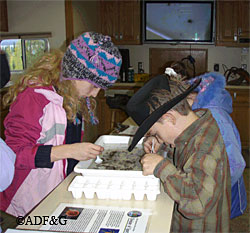Alaska Fish & Wildlife News
November 2007
Mobile Classroom Brings Lakes to Kids

“What aquatic animal has 32 brains?”
“The leech!”
Lukas Patten grinned as he was given an Alaska Department of Fish & Game tattoo sticker for the correct answer to the question posed by Tracy Smith, an Education Associate for the Department.
On a recent brisk and colorful September day, approximately 100 students, teachers and parents joined the Alaska Department of Fish and Game staff for a study of Skilak Lake on the Kenai National Wildlife Refuge. Students from KBeach and Sterling Elementary schools ventured to Skilak Lake to learn about the Kenai River watershed. They studied aquatic insects and plankton, identified juvenile fish and conducted water quality tests.
The students spent half their allotted time in the Mobile Aquatic Classroom peering through microscopes at plankton found in Skilak and Jerome Lakes. They were able to compare a variety of plankton found in a non-glacial lake (Jerome) to representatives of just a few species found in a glacial lake (Skilak). Iisha Oftedal, a student in Teri Diamond’s Sterling Elementary class, commented that the plankton she was observing were “small, but at the mercy of the waves.” They learned that plankton and macroinvertebrates are the main source of food for juvenile fish and that there are 150 species of planktonic Daphnia in North America.
In another section of the classroom, students were tasked with finding an aquatic mite in a tray filled with various macroinvertebrates. These live specimens were found under rocks earlier that morning in a Kenai River tributary. Once the students found the mite, they were asked to draw a picture on their worksheet and list an identifying characteristic. Shelby Fletcher commented the aquatic mite was, “Teeny, teeny, teeny, tiny.” Some of the comments on the worksheets submitted by KBeach students included remarks such as, “They look like tiny spiders that swim, they are big enough to see with the naked eye and they have no backbone.”

Outside the classroom, students were helping ADF&G student volunteer Clancy Skipwith conduct water quality tests on Skilak Lake water samples. Clancy showed the students how to conduct pH, dissolved oxygen, conductivity and turbidity tests on lake water. During the pH tests, the 5th & 6th graders learned they were testing for pollution. They were delighted to discover Skilak Lake tested neutral and dissolved oxygen was at perfect levels to sustain juvenile fish and macroinvertebrate populations.
“If you look at the black dot in the test tube, you can see how much more murky Skilak Lake water is than distilled water,” Skipworth said about the turbid glacial water. “This is a result of Skilak Glacier melting.”
On the other side of the classroom, ADF&G Fish and Wildlife technician Jenny Cope showed the kids an aquarium with juvenile fish. “Can you find the fish with the pink stripe on the lateral line and the black spots on the dorsal fin?” “There he is,” said one of the students. “I see the rainbow trout.”
The students discovered identifying characteristics of juvenile fish, which included the thickness of the parr marks (vertical stripes), coloration on the edges of the fins and spots on the adipose fin. By the time the students walked away from the aquarium, they could identify the juvenile fish species and name the fins and describe their function.
This program is one of the many events presented by ADF&G in Southcentral Alaska to classes as part of the Salmonids in the Classroom program. It further advances both the goals of the Division of Sport Fish’s Strategic Plan as well as the goals of the Aquatic Education strategic plan. Throughout the school year, students learn about the lifecycle of the salmon by raising salmon in the classroom. Students from the Kenai Peninsula Borough School District will attend an egg-take in either Seward or Anchor Point where they will spawn salmon and collect the eggs for their classroom incubation project. They will observe the four early stages of the salmon life cycle (eggs, eyed egg, alevin & fry) from the comfort of their classroom, and release the surviving fry in the spring at permitted locations. They will also learn about salmon anatomy by dissecting salmon in the classroom. In January, they will brave the cold weather on an ice fishing field trip to Sport Lake, hopefully catching chinook salmon and rainbow trout. On the Kenai Peninsula, students will visit a nearby stream or lake to learn first hand about healthy watersheds. Ultimately, the students will understand and appreciate the unique value of Alaska’s aquatic resources and sport fisheries, the factors affecting them and reasons for protecting them, as well as the role of ADF&G in sustaining these valuable resources.
On this September day, the students walked away from their Skilak Lake field trip with an initial understanding of what it takes to make a healthy watershed - while eagerly anticipating their next salmon adventure.

Story & photos by Patti Berkhahn. Patti Berkhahn is a fishery biologist for the Division of Sport Fish and is based in the Soldotna office.
Subscribe to be notified about new issues
Receive a monthly notice about new issues and articles.
